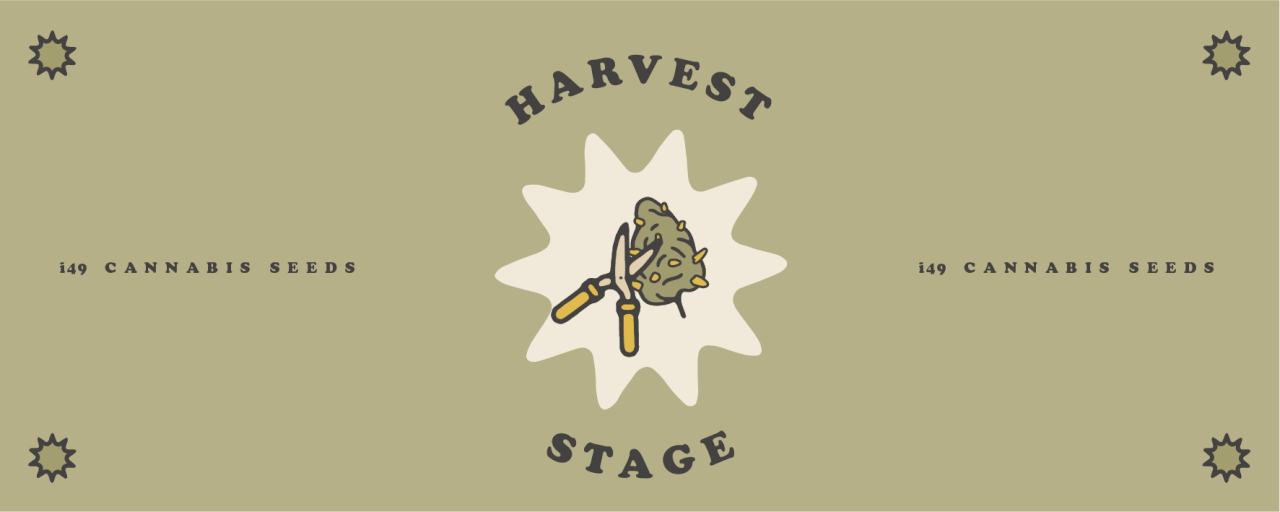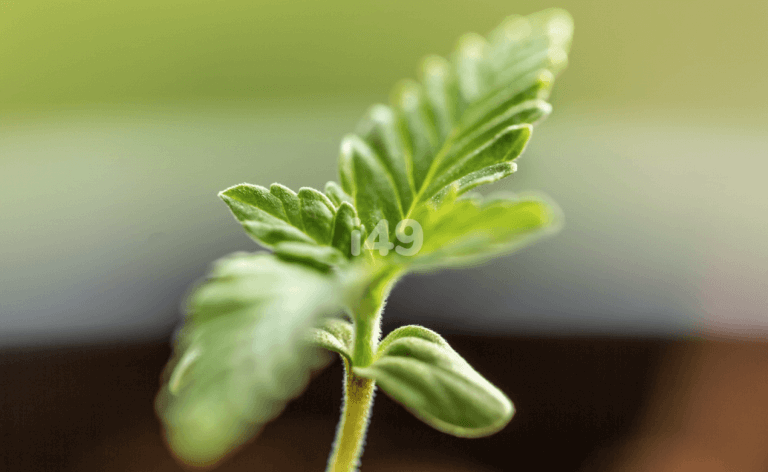Anyone who has cultivated weed, especially from seed, knows that when to harvest cannabis is not to be taken lightly.
The time, energy, and expense involved are investments in the dank output of smooth-smokin’ buds that hit the spot.
However, that labor and love could be for naught if you fail to determine the best time to harvest your weed. Subsequently, lighting up that bad bud can extend your downer for a whole season!
Nobody wants to face harvest day with dread, so read on to ensure you know exactly when to harvest marijuana.
It’s important to harvest cannabis at the right time
When to harvest marijuana is one of the most important factors in shaping your bud’s quality.
Too early and the batch is likely to be less potent, flavorful, and aromatic because resin production hasn’t peaked.
Too late, and you’ll be left with a body-numbing, couchlocking sleep inducer.
We may harvest early to attain the cerebral ‘up’ high. We harvest late to maximize the medicinal cannabinol (CBN) output.
Harvest buds at the right time for the highest potency
When to harvest marijuana can be as important as the actual growing of the plants. A number of methods can make sure you harvest at the most advantageous moment.
From bud shape to effects, from THC to CBD contents, your harvest’s eventual quality depends on finding this key moment. Read on as we discover the optimal time to start harvesting.
How to know when to harvest marijuana
THC levels peak in the late stages of the flowering phase, making this the best time to harvest weed.
However, extending that period doesn’t extend THC production, as the cannabinoid eventually starts to degrade and turn into cannabinol (CBN).
While CBN does have medicinal properties, it lacks the psychoactive effects of THC and thus limits the effects.
Bud shape
While in no way infallible, the shape and feel of the buds can give you a good idea of when to harvest buds.
At this stage, the pistils or ‘hairs’ should have mostly darkened and turned inwards, exposing the solid bud beneath. The buds themselves should be firm, solid, and tight but not squishy.
Also, remember that sativas have longer and fluffier buds, while indicas usually have dense nugs.
Trichome color
Trichome color is, without doubt, the best and most accurate method in assessing how to tell when cannabis is ready to harvest.
The trichomes you’re looking for are the mushroom-shaped ones. These ones have what looks like a ‘head’ or a ‘ball’ on top.
Inside this ‘head’ is where much of the THC or other cannabinoids are located. They also give weed its seriously sticky nature.
Trichomes are often called resin glands, and they sparkle like frosting or crystals. They’re exactly what gives weed its potency and can give us the best indication of when to harvest cannabis for best results.
This depends primarily on the color of these trichomes, so know your trichomes with marijuana plant anatomy!
How to check if buds are ready to harvest
The trichomes will change from clear to opaque to amber during the flowering period. If the trichomes are clear, it’s too soon.
If 50% of the trichomes have turned cloudy or opaque, the buds are still growing, and the odor has not fully developed.
Harvesting marijuana at this point usually provides a more speedy or energetic buzz.
If you’re looking for an intense high, euphoria, and superior pain killing effects, harvest bud when most of the trichomes are cloudy.
If you wait longer, the trichomes will start to turn amber, which indicates the peak of THC production. It also heralds the onset of a narcotic style effect that reduces anxiety.
There are two ways to check when you should be harvesting cannabis.
Look at the buds
First, the pistil method takes aim at the ‘hairs’ present on all buds. These hairs start out white and eventually turn an orange-brown color.
When about 40% have darkened, you can harvest cannabis, but wait until 50–70% have browned for peak potency.
If 70–90% of the hairs are dark, the marijuana harvest is on the late side, and more relaxing highs should result.
Check the buds with a magnifying glass
However, the trichomes are the real showstoppers.
The trichome method is the most accurate way of determining when to harvest weed.
Trichomes are too small to see with the naked eye, but with a modest outlay, we can get close enough to make informed decisions.
Pictures of trichomes ready to harvest
When the majority of your trichomes turn from clear to milky-white, you know when to harvest bud: now!

However, when buds are richer in CBN, trichomes will begin to turn a brownish amber color.

The trichomes turn amber after they have reached maximum potency, so beyond this point, there are diminishing returns.
What tools do you need to check if trichomes are ready to harvest?
There are numerous methods employed that improve visibility to varying degrees, from budget to pro.
Choosing the best time to harvest weed is crucial, so it’s imperative that you can see when your trichomes start changing.
Jeweler’s loupe
Probably the easiest and most cost-effective method to analyze your trichomes is with a jeweler’s loupe.
Simply put the loupe up to the plant and look for the ‘glitter’.
Camera phone
Modern camera phones are eminently capable of shooting a decent image which can then be enlarged.
You’ll need good light and steady hands or a tripod. Focus is king.
Digital microscope
These are able to shoot video and can achieve a tighter focus. Digital microscopes can produce more defined pictures.
They are the surest way of knowing the state of your trichomes and how to tell when marijuana is ready to harvest.
How to tell when it’s too early to harvest weed?
If the hairs or pistils on the buds are still straight and white, it’s too early! The trichomes themselves will still be clear like glass. If you harvest cannabis at this point, your potency and yield will both suffer.

What tools do you need to harvest marijuana?
There are a few things you will need to gather when harvesting marijuana. This is an exciting part of the process and very hands-on.
It’s hard work too, but it’s super rewarding!
Scissors and pruners
We require at least a single pair of quality scissors, capable of speed and accuracy.
For larger branches, use a pair of pruners that can be spring-loaded or not.
Of utmost importance are comfort and effectiveness, as harvesting cannabis can be a time-intensive task.
Clean surface, tray, or bowl
You need a clean, handy tray, bowl, or surface to place the trimmed branches or buds in. Some trimmers like a lap tray for comfort and efficiency.
A screen to collect kief is a great idea too. Any flat, clean surface like a table will suffice. Just store the buds in a bowl.
Rubbing alcohol
Rubbing alcohol is an important part of your armory when harvesting cannabis. This is a sticky business, and your scissors are likely to get gunked up rapidly.
Rubbing alcohol cuts through the resin and cleans your blades, surfaces, and hands with the help of a spare rag.
Comfortable chair
A comfortable chair saves your back as you settle down for a solid session of harvesting marijuana.
Choose a cool place with plenty of light, perhaps some music, and you’re ready to harvest your pot.
How to harvest marijuana—dry trimming
Dry trimming is one cutting method that can be used once you’ve determined the best time to harvest weed.
Dry trimming is when we remove the leaves of the plant only after we’ve dried the plant for 10–14 days.
Flush plants a week before harvest
When you’ve decided when to harvest pot, prepare to start flushing your cannabis.
Do this by feeding the plants only water for the last two weeks.
Cleanse the cannabis harvest with pH-neutral H2O to eliminate the chemical taste, magnifying the natural flavor of the colas.
Prune off some of the bigger branches
When you harvest cannabis, cut off the bigger branches not far from where they meet the stem.
This means you won’t accidentally step on the plant and damage the fragile colas.
It makes the harvest progressive and organized.
Cut off all branches
Next, cut off all the branches you’re going to hang and remove excess leaves. It’s unnecessary to remove all the leaves, as some will keep the buds moist for the first few days.
Hang the branches to dry
Finally, hang the branches to dry. You need a room with a constant temperature of around 70 degrees F.
The humidity is also important—a relative humidity (RH) of 50% is great. If you hang branches upside down, you won’t need to turn them.
Make sure you have a cool, dark spot with decent airflow.
How to harvest cannabis—wet trimming
Wet trimming is the second cutting method, primarily used in humid climates where the potential for mold is higher.
Here the buds are separated from the fan and sugar leaves before drying starts.
-
Flush your plants
Like with dry trimming, the first step is to flush your plants with water a couple of weeks before you intend harvesting cannabis.
-
Cut off the branches
Next, cut off branches, making them easy to handle when snipping off the buds.
When wet trimming, cut branches individually so that you can trim each one first before moving on.
-
Trim the buds from the branches
Trimming immediately after harvesting cannabis is easier, as sugar leaves haven’t closed in on the buds.
Wet trimming means more chlorophyll in the leaves, however, which may lead to a lingering grasslike aroma.
-
Leave buds to dry
Finally, place your carefully trimmed nugs on a drying rack. Leave your marijuana harvest in a cool, dark room with decent airflow.
Remember to turn the buds regularly to dry your crop evenly and to avoid misshapen buds.
Tips for harvesting marijuana
We hope you’ve got a clearer idea of when to harvest marijuana now. As an added bonus, we’ve got some extra tips on how to maximize your time, effort, and yields:
- Attach a label with the strain’s name and the date it started drying to help differentiate between multiple breeds.
- Be on the lookout for ‘friendlies’ that may have made a home in your cannabis harvest, especially for outdoor grows.
- Wear clothes you don’t mind getting filthy—harvesting cannabis can be sticky and dirty work!
- It’s good to harvest buds before the plants get too warm, so it’s best early in the morning outdoors. Indoor grows can be harvested shortly after the lights come on.
What comes next?
After harvesting cannabis and drying marijuana, you can move on to another important part of the process — drying and curing.
Curing is placing your dried cannabis into air-tight jars for a few weeks for a controlled breakdown of residual chlorophyll.
This process helps bring out the delectable taste and aroma locked inside the terpenes. Yum!
Become a harvesting master today
There you have it—our step-by-step guide to harvesting weed plants for optimum potency. We hope it helps!
This is also a great time to start thinking about your next cannabis harvest. If you’re on the lookout for delectable new weed seeds for your next harvest, i49 seed bank has everything you could want.















